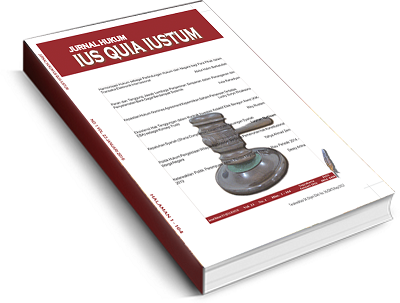Main Article Content
Abstract
The development of digital world has provided various services that are beneficial for the community, one of which is the presence of information technology-based lending and borrowing services or known as peer to peer lending. However, the current applicable regulations have not clearly explained the construction of the legal relations among the parties involved in peer to peer lending platform. Regarding the fact that some peer to peer lending services are similar to those of banks, the Financial Services Authority (OJK) is required to affirm the construction of the legal relations among parties so as to create legal certainty. Based on this explanation, there is a question: how is the Legal Relation among the Parties involved in Peer To Peer Lending in terms of the Legal Certainty for these Parties. This study used a normative method. The results showed that peer to peer lending services providers are not banks that collect funds from the community and distribute them to the community. Therefore, the legal relation among the parties involved in peer to peer lending shall be differentiated from the legal relations among the parties involved in banking sector, especially in the business activities of distributing funds through credit or financing agreements. The legal certainty in peer to peer lending shall be fulfilled so that peer to peer lending business activities are not categorized as an illegal bank and so that this business is able to provide legal standing for all the parties.
Keywords
Article Details
Authors who publish with this journal agree to the following terms:
a. Authors retain copyright and grant the journal right of first publication with the work simultaneously licensed under a Creative Commons Attribution License that allows others to share the work with an acknowledgement of the work's authorship and initial publication in this journal.
b. Authors are able to enter into separate, additional contractual arrangements for the non-exclusive distribution of the journal's published version of the work (e.g., post it to an institutional repository or publish it in a book), with an acknowledgement of its initial publication in this journal.
References
- Buku
- Gazali, Djoni S. dan Rachmadi Usman, Hukum Perbankan, Sinar Grafika, Jakarta, 2012.
- Harahap, M. Yahya, Segi-Segi Hukum Perjanjian, Alumni, Bandung, 1986.
- R. Subekti, Aneka Perjanjian, PT Citra Aditya Bakti, Bandung, 1995.
- Sihombing, Jonker, Penjaminan Simpanan Nasabah Perbankan, PT Alumni, Bandung, 2010.
- Jurnal
- Afaf, Azizah et.al, “Perlindungan Hukum Bagi Pemberi Pinjaman Terhadap Risiko Gagal Bayar Dalam Perjanjian Peer To Peer Lending” Jurnal Hukum http://hukum.studentjournal.ub.ac.id, 2017.
- Peraturan Perundang-Undangan
- Kitab Undang-Undang Hukum Perdata
- Undang-Undang Republik Indonesia Nomor 21 Tahun 2011 tentang Otoritas Jasa Keuangan (Tambahan Lembaran Negara Republik Indonesia Nomor 5253)
- Undang-Undang Nomor 10 Tahun 1998 tentang Perubahan Atas Undang-Undang Nomor 7 Tahun 1992 tentang Perbankan (Tambahan Lembaran Negara Republik Indonesia Nomor 3790)
- Peraturan Otoritas Jasa Keuangan No. 77/POJK.01/2016 tentang Layanan Pinjam Meminjam Uang Berbasis Teknologi Informasi (Lembaran Negara Republik Indonesia Tahun 2016 Nomor 324)
- Peraturan Bank Indonesia No. 3/11/PBI/2001 tentang Perubahan Atas Perubahan Atas Peraturan Bank Indonesia No. 2/24/PBI/2000 tentang Hubungan Rekening Giro Antara Bank Indonesia dengan Pihak Ekstern (Tambahan Lembaran Negara Republik Indonesia Nomor 4108)
- Internet
- “Mandiri Virtual Account” http://www.bankmandiri.co.id/article/commercial-virtual-account.asp diakses pada tanggal 3 Agustus 2017
- “Praktik Bank Gelap” m.hukumonline.com/klinik/detail/lt5003cbf860b91/ praktik-bank-gelap diakses pada tanggal 10 Juli 2017
- “16 Hal yang Wajib Dipenuhi Pemain Peer to Peer Lending dalam Fintech” http://m.hukumonline.com/index.php/berita/baca/lt586e1f6a2e0a2/16-hal-yang-wajib-dipenuhi-pemain-peer-to-peer-lending-dalam-fintech diakses pada tanggal 6 Agustus 2017
- https://uangteman.com/work, diakses pada tanggal 26 Mei 2017
- http://koinworks.com/id/education-center/industri-peer-to-peer-lending diakses pada tanggal 2 Mei 2017
References
Buku
Gazali, Djoni S. dan Rachmadi Usman, Hukum Perbankan, Sinar Grafika, Jakarta, 2012.
Harahap, M. Yahya, Segi-Segi Hukum Perjanjian, Alumni, Bandung, 1986.
R. Subekti, Aneka Perjanjian, PT Citra Aditya Bakti, Bandung, 1995.
Sihombing, Jonker, Penjaminan Simpanan Nasabah Perbankan, PT Alumni, Bandung, 2010.
Jurnal
Afaf, Azizah et.al, “Perlindungan Hukum Bagi Pemberi Pinjaman Terhadap Risiko Gagal Bayar Dalam Perjanjian Peer To Peer Lending” Jurnal Hukum http://hukum.studentjournal.ub.ac.id, 2017.
Peraturan Perundang-Undangan
Kitab Undang-Undang Hukum Perdata
Undang-Undang Republik Indonesia Nomor 21 Tahun 2011 tentang Otoritas Jasa Keuangan (Tambahan Lembaran Negara Republik Indonesia Nomor 5253)
Undang-Undang Nomor 10 Tahun 1998 tentang Perubahan Atas Undang-Undang Nomor 7 Tahun 1992 tentang Perbankan (Tambahan Lembaran Negara Republik Indonesia Nomor 3790)
Peraturan Otoritas Jasa Keuangan No. 77/POJK.01/2016 tentang Layanan Pinjam Meminjam Uang Berbasis Teknologi Informasi (Lembaran Negara Republik Indonesia Tahun 2016 Nomor 324)
Peraturan Bank Indonesia No. 3/11/PBI/2001 tentang Perubahan Atas Perubahan Atas Peraturan Bank Indonesia No. 2/24/PBI/2000 tentang Hubungan Rekening Giro Antara Bank Indonesia dengan Pihak Ekstern (Tambahan Lembaran Negara Republik Indonesia Nomor 4108)
Internet
“Mandiri Virtual Account” http://www.bankmandiri.co.id/article/commercial-virtual-account.asp diakses pada tanggal 3 Agustus 2017
“Praktik Bank Gelap” m.hukumonline.com/klinik/detail/lt5003cbf860b91/ praktik-bank-gelap diakses pada tanggal 10 Juli 2017
“16 Hal yang Wajib Dipenuhi Pemain Peer to Peer Lending dalam Fintech” http://m.hukumonline.com/index.php/berita/baca/lt586e1f6a2e0a2/16-hal-yang-wajib-dipenuhi-pemain-peer-to-peer-lending-dalam-fintech diakses pada tanggal 6 Agustus 2017
https://uangteman.com/work, diakses pada tanggal 26 Mei 2017
http://koinworks.com/id/education-center/industri-peer-to-peer-lending diakses pada tanggal 2 Mei 2017




